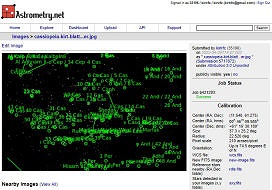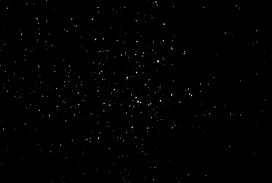|
<Previous
Next>

Cassiopeia star field plate-solved by Astrometry.net

Original Cassiopeia image taken with my SLR camera using 400
ASA B&W film, c1984.
The term "plate solving"
(aka "astrometric solving") in astronomy has its roots in the days when dinosaurs
roamed the earth and images of the sky were captured on, gasp, glass plates with
photosensitive emulsion coatings. Attempting to identify astronomical items on a
plate, or paper photograph developed from a plate, was/is similar to finding an
unfamiliar star, nebula, or galaxy when viewing the heavens through binoculars or
a telescope. You begin with a nearby entity you are familiar with, and then move
in the direction of the object being sought. Sometimes a process known as "star
hopping" is used to move from point to point in a predictable combination of direction
and distance from the current star (or whatever).
With the advent of digital photography, software programmers have developed algorithms
that assess and map all the points in an image, then compare it to a calibrated set
of points from carefully processed images and attempt to identify all the astronomical
objects in the investigated image. Only fairly recently has a highly efficient method
of computer plate solving been available.
Fortunately, the community of professional and
amateur
astronomers has produced a plethora of software tools for capturing and processing
images. The incredible, full-color (and often image-enhancing false color) pictures
of nebulas, galaxies, globular clusters, planets, comets, asteroids, etc., which
used to be the exclusive domain of high-priced professional instruments, now fill
the Internet and printed publications compliments of backyard astronomers whose
astrophotographs were captured with anything from a smartphone camera to a proprietary
liquid-cooled image sensor. Image stacking is used to combine multiple images of
the same object or area of the sky in order to increase contrast and sharpness,
and cancel noise. Rather than requiring long time exposures in a single session,
combining the light collected by many shorter exposures often produces a superior
result, although for extremely faint objects long light collection times are required.
I have used RegiStax extensively,
but there are many other good programs available such as
DeepSkyStacker.
Shown above is an example of plate solving done by the
Astrometry.net
website on my c1984 black and white photograph made by a Pentax SLR camera
(using Kodak 400 ASA film) mounted on top of my
Criterion RV-8, 8" Newtonian telescope. It contains more information than I
would ever have attempted to determine on my own, but unfortunately, it does not
flag an unknown objet that will turn out to be a new star which could be named CasBlatt1984.
If you have any astroimages of your own, regardless of how
or when they were taken, you might try running it (them) through
Astrometry.net and see what comes up.
The technology is truly amazing.
Posted April 29, 2022
|



























 "
"

